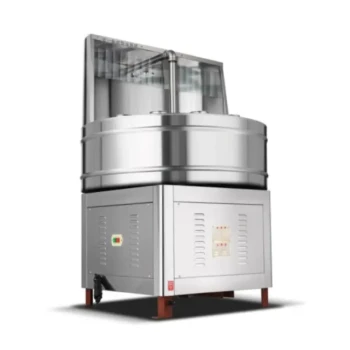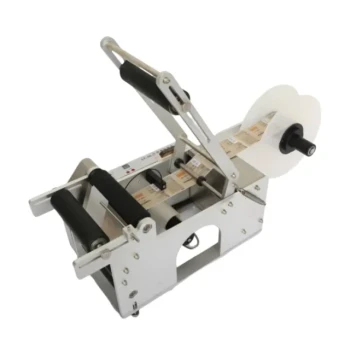At its core, a honey dryer removes water from honey using a continuous cycle of evaporation and condensation. It combines a large surface area, created by rotating platters, with a constant flow of warm, dry air. This process accelerates the natural removal of moisture, ensuring the honey's final water content is low enough to prevent fermentation and spoilage.
The central challenge is that honey with over 20% water content can ferment. A honey dryer solves this by operating as a closed-loop dehumidifier: it uses warm air to pull moisture from the honey, then condenses that moisture out of the air before reheating and recirculating it for maximum efficiency.

The Core Problem: Why Honey Needs Drying
The Fermentation Threshold
Honey is a supersaturated sugar solution. If its water content rises above a critical threshold, typically around 18-20%, naturally present yeasts can become active and cause it to ferment.
The ideal moisture content for stable, high-quality honey is between 17% and 18%. A honey dryer is a corrective tool used to achieve this standard when it cannot be met naturally.
How Honey Absorbs Excess Water
Honey is hygroscopic, meaning it readily absorbs moisture from its surroundings. This can happen if honey is harvested prematurely before bees have capped the comb, or if it's processed and stored in a high-humidity environment.
The Mechanics of a Honey Dryer: A Step-by-Step Process
A professional honey dryer is an engineered system designed to remove water gently and efficiently. It operates on a continuous, closed-loop principle.
Step 1: Maximizing Surface Area
The honey is spread into a very thin film over a series of rotating discs or platters. These platters spin slowly, constantly exposing new surfaces of the honey to the air. This dramatically increases the rate of evaporation compared to honey sitting in a tank.
Step 2: The Role of Warm, Dry Air
The system generates a current of warm, dry air. Warm air has a higher capacity to hold moisture than cold air, making it like a "thirsty" sponge ready to absorb water.
Step 3: Evaporation and Moisture Transfer
This carefully warmed, dry air flows over the thin film of honey on the platters. The water molecules on the surface of the honey evaporate, leaving the honey and becoming suspended in the air.
Step 4: Condensation and Dehumidification
The now warm, moist air is circulated away from the honey and over a cold surface, typically the evaporator coils of a refrigeration unit. As the air cools rapidly, it can no longer hold the moisture, which condenses into liquid water and is drained away.
Step 5: Recirculation for Efficiency
After passing over the cold coils, the air is now dry again. It is then reheated to the optimal temperature and recirculated back over the honey to pick up more water. This closed-loop process makes the system highly efficient.
Understanding the Key Considerations
The Risk of Overheating
Heating honey excessively can destroy its delicate enzymes, darken its color, and alter its flavor profile. Professional dryers use very gentle, controlled heat—just enough to facilitate evaporation without damaging the honey's quality.
Time vs. Moisture Content
The drying process is not instantaneous. The time required depends on the initial water content of the honey, the ambient humidity, and the dryer's efficiency. Reducing moisture content by even a few percentage points can take several hours.
Not a Substitute for Proper Harvesting
The most reliable way to ensure proper moisture content is to harvest honey only after the bees have capped the cells, signifying that they have already reduced the water content themselves. A dryer is an essential tool for correction, not a replacement for good beekeeping practices.
Making the Right Choice for Your Goal
Achieving the correct moisture level is a balance between preservation and quality.
- If your primary focus is preserving raw honey quality: Use the lowest effective temperature setting on the dryer to protect the natural enzymes and delicate aromatics.
- If your primary focus is preventing fermentation: Your goal is to consistently bring the final moisture content below the 18% threshold, which you should verify with a honey refractometer.
- If your primary focus is operational efficiency: Ensure your system maximizes both air circulation and honey surface area, as these are the two key factors that accelerate the drying process.
By mastering moisture control, you ensure every jar of your honey remains stable, flavorful, and of the highest possible quality.
Summary Table:
| Key Function | How It Works | Benefit |
|---|---|---|
| Maximizes Surface Area | Honey is spread in a thin film over rotating platters. | Dramatically increases the rate of water evaporation. |
| Gentle Evaporation | Warm, dry air flows over the honey, absorbing moisture. | Removes water without damaging honey's delicate enzymes and flavor. |
| Closed-Loop Dehumidification | Moist air is cooled to condense water, then reheated and reused. | Highly energy-efficient and prevents humidity from re-entering the honey. |
| Prevents Fermentation | Systematically reduces moisture content to the ideal 17-18% range. | Ensures honey stability, long shelf life, and consistent quality. |
Ensure Your Honey Meets the Highest Quality Standards
For commercial apiaries and beekeeping equipment distributors, consistent moisture control is non-negotiable for product quality and brand reputation. HONESTBEE supplies professional-grade honey dryers and beekeeping equipment designed for high-volume, wholesale-focused operations.
Partner with us to:
- Prevent Fermentation: Achieve the precise 17-18% moisture content that guarantees stable, shelf-ready honey.
- Preserve Quality: Our equipment uses gentle, controlled heat to protect the natural enzymes, color, and flavor profile of your honey.
- Boost Efficiency: Our wholesale-focused solutions are engineered for reliability and efficiency in demanding commercial environments.
Let's discuss the right honey drying solution for your business.
Contact our experts today for a consultation to learn more about our products and wholesale pricing.
Visual Guide

Related Products
- Economy Small Scale Honey Dryer Dehumidifier Thickening Machine
- 0.5T Capacity Honey Dehumidifier Dryer with Vacuum Heating and Thickening Filtering Machine
- High Quality Honey Dehumidifier Dryer Thickening Machine for Beekeeping
- HONESTBEE 72 Frame Industrial Electric Honey Extractor for Beekeeping
- Honey Concentrating Vacuum Heating Thickening Machine Dehumidifier for Honey
People Also Ask
- How does temperature regulation help in managing honey moisture content? Prevent Fermentation & Ensure Quality
- How can the moisture content of honey be reduced? A Guide to Safe, Effective Drying Methods
- What are some tips for preventing excess moisture in honey during harvesting? Essential Steps for a Stable Harvest
- Can you dehumidify honey? A Beekeeper's Guide to Preventing Fermentation
- How to reduce moisture level in honey? Preserve Quality and Prevent Fermentation



















